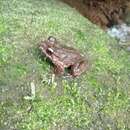en
names in breadcrumbs


Craugastor vulcani is a species of frog in the family Craugastoridae. It is endemic to the Sierra de los Tuxtlas range in southern Veracruz state, Mexico.[1][2] Its name refers to its type locality on the San Martin Tuxtla volcano.[2][3] Common name Volcan San Martin rainfrog has been proposed for it.[1][2]
Adult males measure 40–47 mm (1.6–1.9 in) in snout–vent length [although males as small 31 mm SVL had nuptial pads] and adult females 60–75 mm (2.4–3.0 in) SVL. The tympanum is distinct. The fingers and toes bear well-developed discs. The fingers have lateral keels while the toes have lateral flanges and are moderately webbed. The eyelids have numerous medium-sized, rounded tubercles. Skin of the dorsum is rugose with groups of tubercles and short glandular folds, and typically with well-defined parietal and suprascapular ridges. The dorsal coloration is variable: olive brown, reddish brown, or dark smokey gray, and either uniformly colored or with an irregular middorsal yellow or orange stripe; some individuals are mottled with dark brown. The sides are paler, usually pale yellow-brown or tan suffused with brown. The venter is cream to buff. Males have dark melanophores in their chest and belly while females have immaculate bellies. The iris is bronze.[3]
Craugastor vulcani occurs in premontane and lower montane wet forests at elevations up to 1,200 m (3,900 ft) above sea level. It occurs along streams. Development is direct[1] (i.e., there is no free-living larval stage[4]).
The species is threatened by habitat loss (deforestation) and its distribution area is small, prompting classification as an endangered species. It occurs in the Los Tuxtlas Biosphere Reserve, but significant deforestation is occurring in this reserve.[1]
Craugastor vulcani is a species of frog in the family Craugastoridae. It is endemic to the Sierra de los Tuxtlas range in southern Veracruz state, Mexico. Its name refers to its type locality on the San Martin Tuxtla volcano. Common name Volcan San Martin rainfrog has been proposed for it.
Craugastor vulcani[1][2][3] es una especie de anfibio anuro de la familia Craugastoridae.
Esta especie es endémica del estado de Veracruz en México. Habita entre los 400 y 1200 m de altitud en la sierra de los Tuxtlas.[4]
Craugastor vulcani es una especie de anfibio anuro de la familia Craugastoridae.
Craugastor vulcani Craugastor generoko animalia da. Anfibioen barruko Craugastoridae familian sailkatuta dago, Anura ordenan.
Craugastor vulcani Craugastor generoko animalia da. Anfibioen barruko Craugastoridae familian sailkatuta dago, Anura ordenan.
Craugastor vulcani est une espèce d'amphibiens de la famille des Craugastoridae[1].
Cette espèce est endémique de l'État de Veracruz au Mexique[1]. Elle se rencontre de 400 à 1 200 m d'altitude dans la sierra de los Tuxtlas.
Craugastor vulcani est une espèce d'amphibiens de la famille des Craugastoridae.
Craugastor vulcani is een kikker uit de familie Craugastoridae. De soort werd voor het eerst wetenschappelijk beschreven door Frederick A. Shannon & John E. Werler in 1955. Oorspronkelijk werd de wetenschappelijke naam Eleutherodactylus vulcani gebruikt.[2]
De soort komt voor in delen van Midden-Amerika en leeft endemisch in het gebergte Sierra de los Tuxtlas in een deelstaat van Mexico namelijk Veracruz. De kikker is bekend van een enkele locatie op een hoogte van 400 tot 1200 meter boven zeeniveau. Craugastor vulcani wordt bedreigd door het verlies van habitat.[3]
Craugastor vulcani é uma espécie de anfíbio da família Craugastoridae.
É endémica do México.
Os seus habitats naturais são: florestas subtropicais ou tropicais húmidas de baixa altitude, regiões subtropicais ou tropicais húmidas de alta altitude e rios.[1]
Craugastor vulcani é uma espécie de anfíbio da família Craugastoridae.
É endémica do México.
Os seus habitats naturais são: florestas subtropicais ou tropicais húmidas de baixa altitude, regiões subtropicais ou tropicais húmidas de alta altitude e rios.